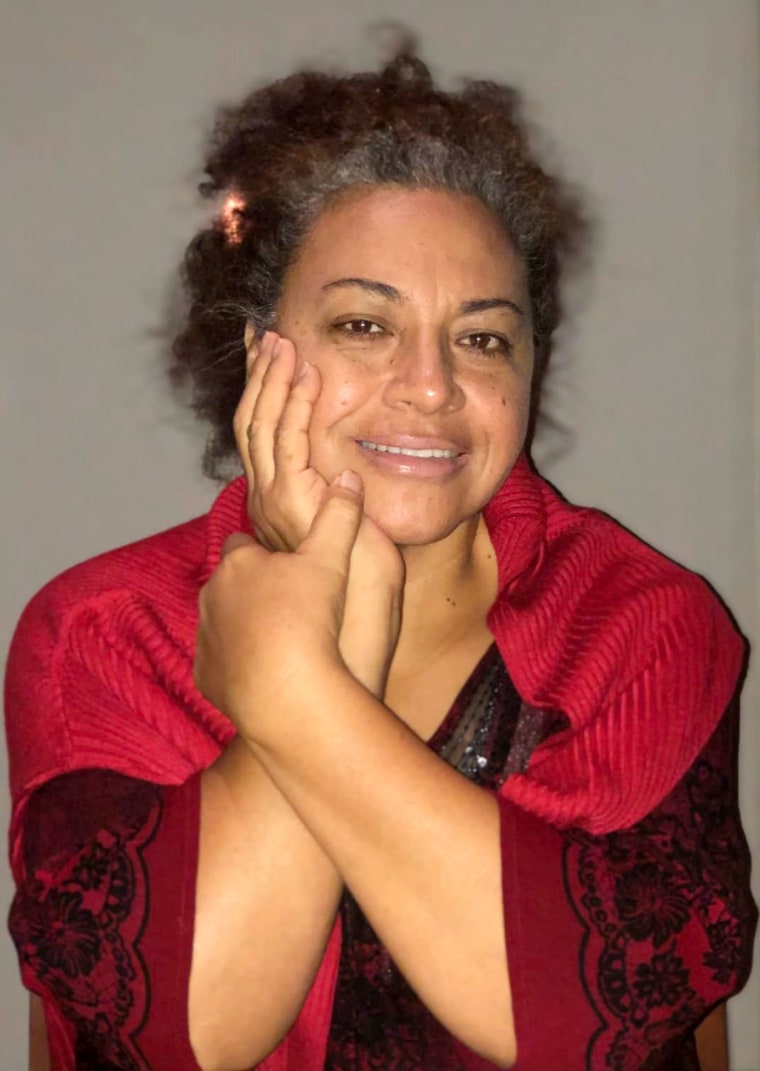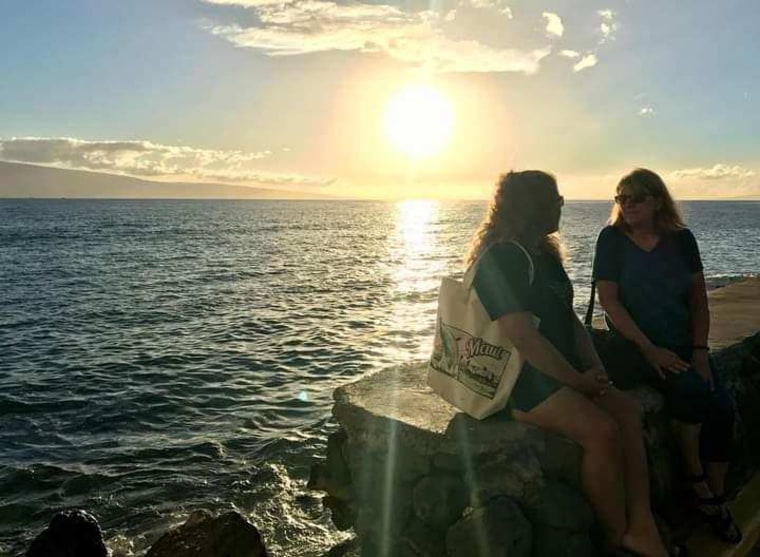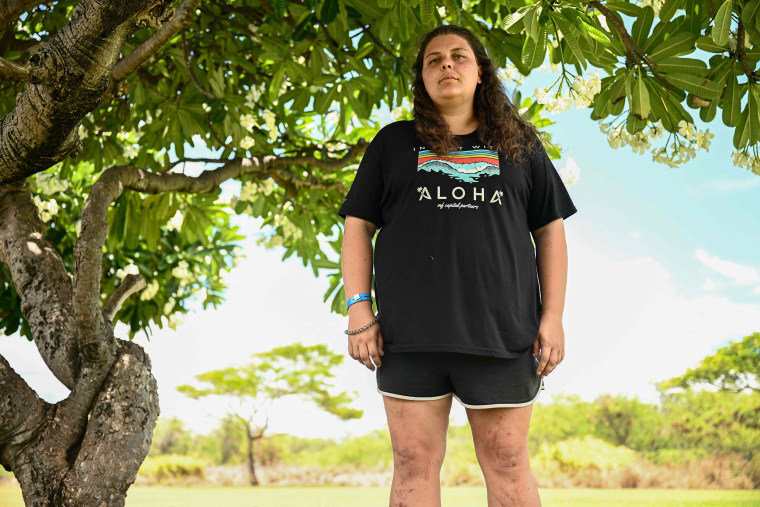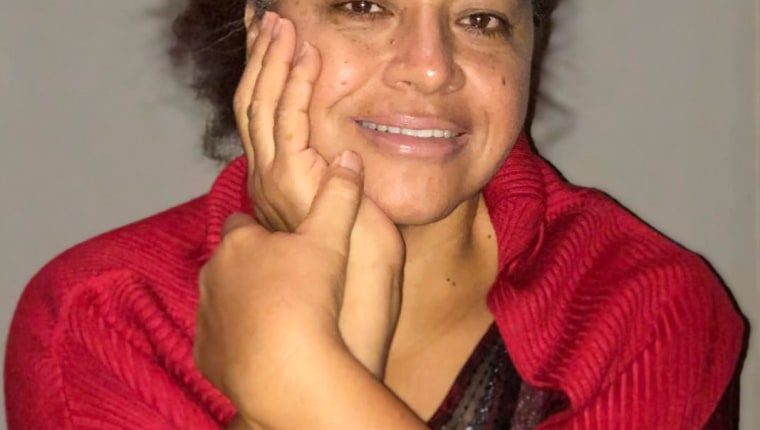One of the many abandoned cars near the shoreline of the Hawaiian island of Maui exploded, shaking the earth and blanketing the dozens of people bobbing in the ocean with a brief blast of heat.
In the chilly Pacific waters, where they had spent hours fighting against the powerful pull of tides, the wave of warmth was welcome.
“We needed it,” Etina Hingano said before pausing. “That one time.”

Hingano, 54, watched from the ocean — her head and singed hand resting on a rock — as the deadliest wildfire in modern U.S. history scorched her historic hometown of Lahaina last week.
The rest of Hingano’s body was submerged in the water so she would not get burned again by falling embers. Her face was caked in a layer of ash, which felt like paper when she splashed water on it.
Around her, a crying toddler clutched a stranger’s neck, a family of five floated on a drifting piece of plywood, an elderly woman in a wheelchair sat on a pile of rocks, two teenagers rubbed their mother’s arms to keep her warm.
In the pitch-black afternoon, when only the orange of the embers pierced through the thick plumes of smoke, Hingano stopped shivering for a moment. But then the noxious fumes came, burning her throat and starving her body of the little oxygen it had.
“I just remember thinking to myself, I’m going to die,” she said.
When wind-fueled wildfires ripped through parts of Maui last Tuesday, it gave residents and tourists seeking refuge from the flames only seconds to weigh their risks. Fearing the blaze more than open water, about 40 people scaled Lahaina’s seawall and plunged into the Pacific, several survivors said.
In the nine hours that they waited in roughly waist-deep water to be rescued, they battled hypothermia and lack of oxygen, as they summoned strength to stay awake, dodge embers and avoid being swept out to sea.
The harrowing escape into the ocean, pieced together through interviews with survivors, shows the resilience of the island community and the far-reaching toll of a disaster that officials say has killed at least 111 people, as thousands of displaced residents work toward recovery and officials continue to identify remains.
A ‘horseshoe of fire’ closes in
No emergency sirens were activated on Lahaina. But around 4 p.m. on Aug. 8, the blaring sounds of hundreds of home smoke detectors going off all at once told Annelise Cochran there was trouble.
Within minutes, Cochran said she saw an ember the size of a small boulder shoot through the air and land in a parking lot behind her apartment complex. She put her pet bird in her car and, like many of her neighbors, she made her way toward the ocean.
Her attempt to evacuate ended at Front Street, Lahaina’s business hub and main thoroughfare, which was jammed with cars — some abandoned, some with drivers as confused as Cochran.

In the gridlock, flames threatened her from left and right. “It was like a horseshoe of fire closing in,” Cochran, 30, said.
Still, she stayed in her car, where fresh air was circulating, for as long as she could. But once the building directly next to her began to smoke, Cochran bolted for the seawall, regrettably leaving her bird in the car.
In the ocean, Cochran was not alone. Her heart broke seeing the shared desperation that surrounded her.
“From the moment that I got out of my car,” she said, “I knew that moment that some of those people would not make it.”
Hingano was already there with her 80-year-old friend, Freeman Tam Lung, who had trouble walking. Tam Lung had not wanted to evacuate, but Hingano said she insisted he come with her.
Embers landed on Tam Lung’s shirt as they fled, but Hingano quickly put out the flames on his back using her bare hands.
They were the first over the wall, but not for long.
“Everybody was crying,” Hingano said. “I felt so bad for them.”
Overnight, stronger tides and colder water
As night fell, the tides grew stronger, Hingano said. The waves hit her over her head. Twice, she said, they lifted her up and slammed her body against the rocks.
She clung to a rope that boaters use to anchor their vessels. “It was the only thing that kept me from sweeping out into the ocean,” she said.
Elsewhere in the sea, Noah Tomkinson, 19, repeatedly assured his 13-year-old brother, Milo, and their mother that they would be OK. Deep down, he didn’t think they would get rescued.
Some of the survivors still had working cellphones, including Cochran, whose device had 16% battery life, and Noah, who video–recorded some of the ordeal. They called 911. But dispatchers told them there was currently no clear and safe path to reach them through the barrier reef at sea, and through the swarm of deserted cars on land, they said.
“They couldn’t get to us,” Milo said. “We were just trapped in the ocean.”
Those with phones waved around their flashlights to alert anyone to their location, but the tiny cluster of white lights could not contend with the fury of the wildfire. “Nobody could see them,” Hingano said.
Noah began hatching plans, including the possibility of swimming out deeper to another part of the island once daylight came.
Meanwhile, stomach-deep in the water, his family shivered. The brothers huddled around their mother to keep her warm, grateful to be together.
“If any of us were alone,” Noah said, “I don’t know if we would have made it.”
Nearby, hypothermia and the effects of low oxygen began to set in for Hingano and Cochran. The two held each other to stay warm, as they slipped in and out of consciousness.


“I would feel my face hit the surface of the water, and that would startle me awake,” said Cochran, a maritime professional. “Every time I remembered to, I’d tap her and say, ‘Etina, wake up. Wake up.’ She did the same for me.”
“That’s the closest she and I came to death,” Cochran added.
Hingano had lost sight of Tam Lung, who she said eventually climbed back up the seawall, intent on seeing the land.
“He said, ‘I just want to see Lahaina one last time the way it is.’ He wanted to see it while it was still Lahaina,” Hingano said.
When she heard Tam Lung scream out her name, she stood up at the same time that another nearby car exploded. The force of the blast made her fall back into the water. “The fumes overtook me,” she said.
It was the last time she heard his voice.
Hingano struggled to breathe, as nagging thoughts filled her mind. Could she have done something different to help him? Near hyperventilating, she inhaled tiny puffs of air close to the water’s surface, where she said there was less smoke.
Then she felt somebody grab her shirt and lift her up. It was her former high school classmate David Pakaki.
“He said, ‘I’m not going to let you die today,'” Hingano recalled. “He said, ‘Take your time, just breathe.’”
Pakaki threw a thick plastic tarp over their heads to shield them against the embers. Every now and then, the pair had to dunk the tarp in the water to cool it down.
“The wind kept blowing the smoke straight towards us. We were breathing it in for hours,” said Pakaki, 54, who was born and raised in Lahaina. “That’s why I thought I wasn’t going to make it — not the fire, but the smoke.”
Nine hours later, rescue and relief
Around midnight, the survivors could see the U.S. Coast Guard attempt to breach the barrier reef. Hingano said two surfers came to save two small children first. Then, around 1:30 a.m., firefighters reached the seawall.
By then, Hingano was so dizzy she fell off the wall, tumbled down the rocks, hit her head and plunged back into the ocean.
Hingano, Cochran and close to 30 others were part of the second batch of survivors to be taken to a grocery store by firetruck. From there, they were transferred by bus to Maui Preparatory Academy and then eventually to shelters.
The U.S. Coast Guard said it rescued 17 people from the water. A week after the disaster hit, it’s unclear how many bodies have been pulled from the sea. The agency did not immediately respond to multiple requests for comment.
For three days after the fire, Hingano said, “all I spit out was black.”
Officials have not yet identified Tam Lung as one of the fatalities of the fire, but Hingano and Cochran said they later saw him slumped against the seawall, unresponsive. They said Tam Lung was not taken in the trucks carrying survivors.
The community has been mourning Tam Lung, a lifelong Lahaina resident and father of three, who was remembered for his happy and light-hearted disposition.
“He loved Lahaina with all his heart,” said Aaron Kamaunu, one of Tam Lung’s best friends. “Everything was no worries, no worries.”
Kamaunu, 61, said he called Tam Lung as he evacuated to make sure he was safe. Tam Lung laughed and assured his friend that he was fine. Then their call got disconnected.
Survivor’s guilt and regret over not being able to save Tam Lung have kept Hingano awake at night for more than a week. On Wednesday, she spoke to a therapist for the first time, which brought her some peace.
When she reunited with Cochran, the two cried together and needed assurance from each other that what they had experienced really happened.
“I just told myself, how the hell did I survive that?” Hingano said. “I didn’t realize the strength of fire. I didn’t realize the strength of water.”
Source: | This article originally belongs to Nbcnews.com










